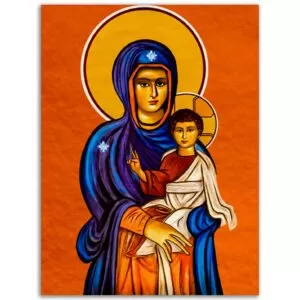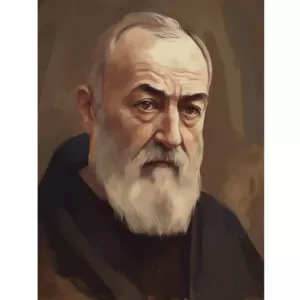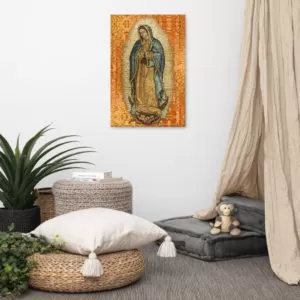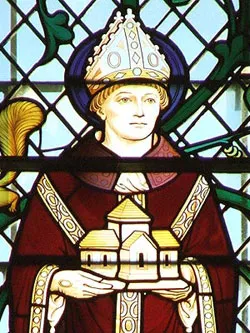SAINT BENEDICT, ABBOT

SAINT BENEDICT ABBOT
Saint Benedict was born about the year 480 at Nursia, in the province of Umbria, in north central
Italy, and that his family was probably of noble lineage. We also know that he had a sister called Scholastica, who from childhood vowed herself to God.
Saint Benedict was sent to Rome to be educated but he was quickly revolted by the licentiousness of his fellow students. He decided to go away from Rome to live in some remote spot. No one knew of his plan except an aged family servant, who loyally insisted on accompanying him to serve his wants. Benedict and this old woman made their way to a village called Enfide, in the Sabine Mountains, some thirty miles from Rome. In the Dialogues, Saint Gregory gives us a series of remarkable incidents associated with Benedict’s life, one of them occurring at this time. While staying in the village, Benedict miraculously mended an earthen sieve which his servant had broken. Wishing to escape the notice and the talk which this brought
upon him, he soon started out alone in search of complete solitude.Up among the hills he found a place known as Subiaco or Sublacum, beneath the lake. It was near the ruins of one of Nero’s
palaces. He made the acquaintance of a monk called Romanus, and to him Benedict revealed his desire to become a hermit. Romanus, who lived in a monastery not far away, gave the young man a monastic habit made of skins and led him up to an isolated cave.
According to Pope Gregory, the first outsider to find his way to the cave was a priest, who while preparing a special dinner for himself on Easter Sunday heard a voice saying to him: “Thou art preparing thyself a savoury dish while my servant Benedict is afflicted with hunger.” The priest immediately set out in search of Benedict, and finally discovered his hiding place. Benedict was astonished, but before he would enter into conversation with his visitor he asked that they might pray together. From that time on, others made their way up the steep cliff, bringing such small offerings of food as the holy man would accept and receiving from him instruction and advice.
Saint Benedict had to struggle with temptations of the flesh and the devil. One of these struggles is described by Saint Gregory. “On a certain day when he was alone the tempter presented himself. A small dark bird, commonly called a blackbird, began to fly around his face and came so near him that, if he had wished, he could have seized it with his hand. But on his making the sign of the cross, the bird flew away. Then followed a violent temptation of the flesh, such as he had
never before experienced. The evil spirit brought before his imagination a woman whom he had formerly seen, and inflamed his heart with such vehement desire at the memory of her that he had very great difficulty in repressing it. He was almost overcome and thought of leaving his solitude. Suddenly with the help of divine grace he found the strength he needed. Seeing near at hand a thick growth of briars and nettles, he stripped off his habit and cast himself into the midst of them and plunged and tossed about until his whole body was lacerated. Through those bodily wounds he cured the wounds of his soul.” Never again was he troubled in the same way.
Between Tivoli and Subiaco, at Vicovaro, on the summit of a fortified rock overlooking the Anio, there lived at that time a community of monks. Having lost their abbot by death, they now came in a body to ask Benedict to accept the office. He at first refused, assuring the monks that their ways and his would not agree. They persuaded him to return with them. It soon became
evident that the severe monastic discipline he instituted did not suit their lax habits, and in order to get rid of him they finally poisoned his wine. When he made the sign of the cross over the cup it broke as if a stone had fallen on it. “God forgive you, brothers,” Benedict said serenely. “Why have you plotted this wicked thing against me? Did I not tell you beforehand that my ways would not accord with yours? Go and find an abbot to your taste, for after what you have done you can no longer keep me with you.” Then he bade them farewell and returned to Subiaco.
Disciples now began to gather around Saint Benedict. At last he found himself in a position to initiate the great work for which God had been preparing him. This was the idea that had slowly been germinating during his years of isolation: to bring together those who wished to share the
monastic life, both men of the world who yearned to escape material concerns and the monks who had been living in solitude or in widely scattered communities, to make of them one flock, binding them by fraternal bonds, under one observance, in the permanent worship of
God. His scheme was for the establishment in the West of a single great religious order which would end the capricious rule of the various superiors and the vagaries of individual anchorites.
Those who agreed to obey Benedict in this enterprise, he settled in twelve monasteries of twelve monks each. Although each monastery had its own prior, Benedict himself exercised general control over all of them from the monastery of Saint Clement.
The town of Cassino, formerly an important place, had been destroyed by the Goths, and the remnant of its inhabitants, left without a priest, were relapsing into paganism; the once-fertile land had fallen out of cultivation. From time to time the inhabitants would climb up through the woods to offer sacrifices in an ancient temple dedicated to Apollo, which stood on the crest of Monte Cassino. Benedict’s first work, after a preliminary forty-day fast, was to preach to the people and win them back to the faith. With the help of these converts, he proceeded to overthrow the pagan temple and cut down the sacred grove. He built two oratories or chapels on the site; one he dedicated to Saint John the Baptist and the other to Saint Martin. Round about these sanctuaries new buildings were erected and older ones remodeled which was to become the most famous abbey the world has known. The foundation was laid by Benedict probably about the year 520.
It was probably during this period that Benedict composed his famous Rule. Gregory says that in it may be perceived “all his own manner of life and discipline, for the holy man could not possibly teach otherwise than as he lived.” Although the Rule professes only to lay down a pattern of life for the monks at Monte Cassino, it served as a guide for the monks of the whole Western Empire. It is addressed to all who, renouncing their own will, take upon them “the strong and bright armor of obedience, to fight under our Lord Christ, our true king.” It prescribes a diversified routine of liturgical prayer, study, and physical work, in a community under one father. It was written for laymen by one who was not a priest; only after some five hundred years were clerical orders required of Benedictines. Its asceticism was intended to be reasonable; the monks abstained from flesh meat and did not break fast until mid-day.
Benedict extended his solicitude to the people of the countryside. He cured the sick, relieved the distressed, distributed alms and food to the poor, and is said on more than one occasion to have raised the dead. When Campania suffered from a famine, he gave away all the provisions stored in the abbey, with the exception of five loaves. “You have not enough today,” he said to his monks, noticing their dismay, “but tomorrow you will have too much.” Benedict’s faith had its reward. The next morning a large donation of flour was deposited by unknown hands at the monastery gate. Other stories were told of prophetic powers and of an ability to read men’s thoughts. A nobleman he had converted once found him in tears and inquired the cause of
his grief. Benedict astounded him by replying that the monastery and everything in it would be delivered to the pagans, and the monks would barely escape with their lives. This prophecy came true some forty years later, when the abbey was wrecked by a new wave of invaders, the pagan Lombards.
Totila, King of the Goths, had defeated the Emperor Justinian’s army at Faenza and in 542 was making a triumphal progress through central Italy towards Naples. On the way he wished to visit
Benedict, of whom he had heard marvelous tales. Totila now came himself to the abbey and was so awed by Benedict that he fell prostrate. Benedict, raising him from the ground, rebuked him sternly for his cruelties and foretold in a few words all that should befall him. “Much evil,” he said, “dost thou do and much wickedness hast thou done. Now, at least, make an end of iniquity. Rome thou shalt enter; thou wilt cross the sea; nine years thou shalt reign, and die the tenth. Benedict did not live long enough to see the prophecy fulfilled.
He who had foretold so many things was forewarned of his own death, and six days before the end bade his disciples to dig a grave. As soon as this was done, Benedict was stricken with a fever, and on the sixth day, while the brethren supported him, he murmured a few words of prayer and died, standing, with hands uplifted towards Heaven. He was buried beside his sister Scholastica, on the site of the altar of Apollo which he had thrown down. His symbols are reminders of various incidents in his life: we see him with a blackbird, a broken sieve, a rose bush, a scourge, a dove, a globe of fire, or a luminous stairway up which he is proceeding to Heaven; occasionally he is depicted with King Totila at his feet. The order which Benedict founded has spread over the earth. It was mainly responsible for the conversion of the Teutonic races, and has left its mark on the education, art, and literature of Europe. Within its cloisters, always marked by an atmosphere of industry and peace, were copied and recopied the great writings of the past, to be cherished and passed on to succeeding generations.
Saint Benedict, Abbot. Feast Day is March 21.
rosary.team
















